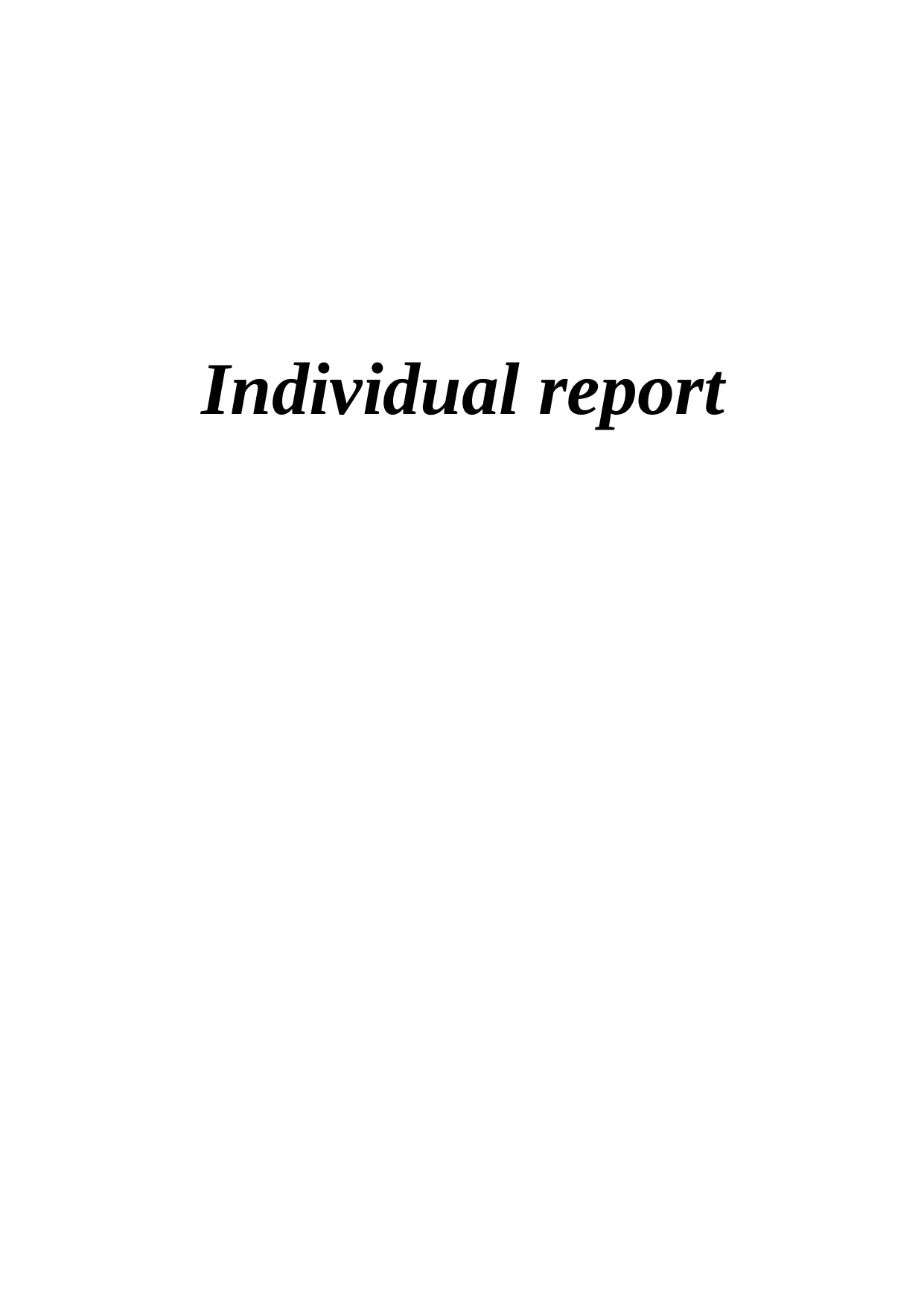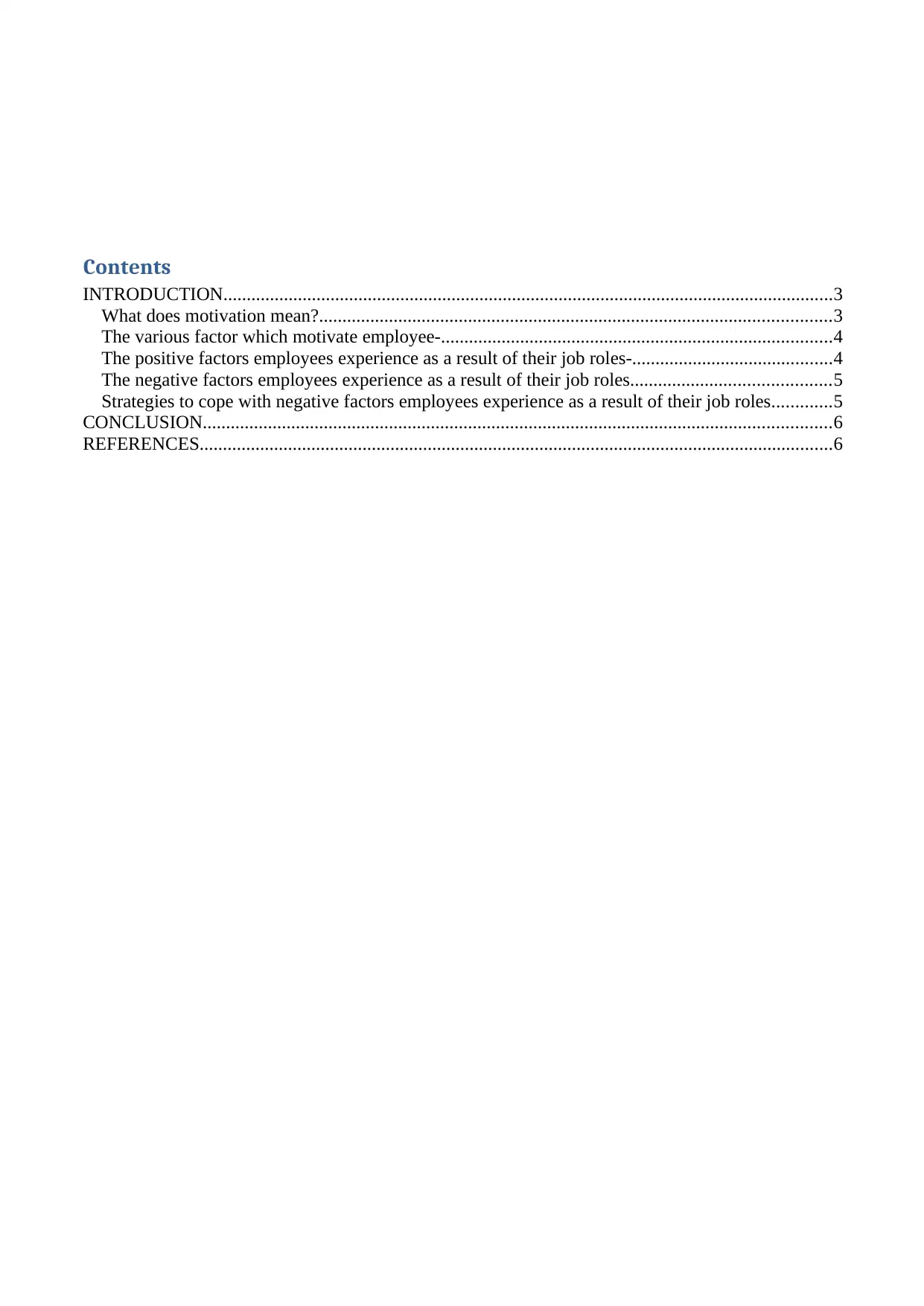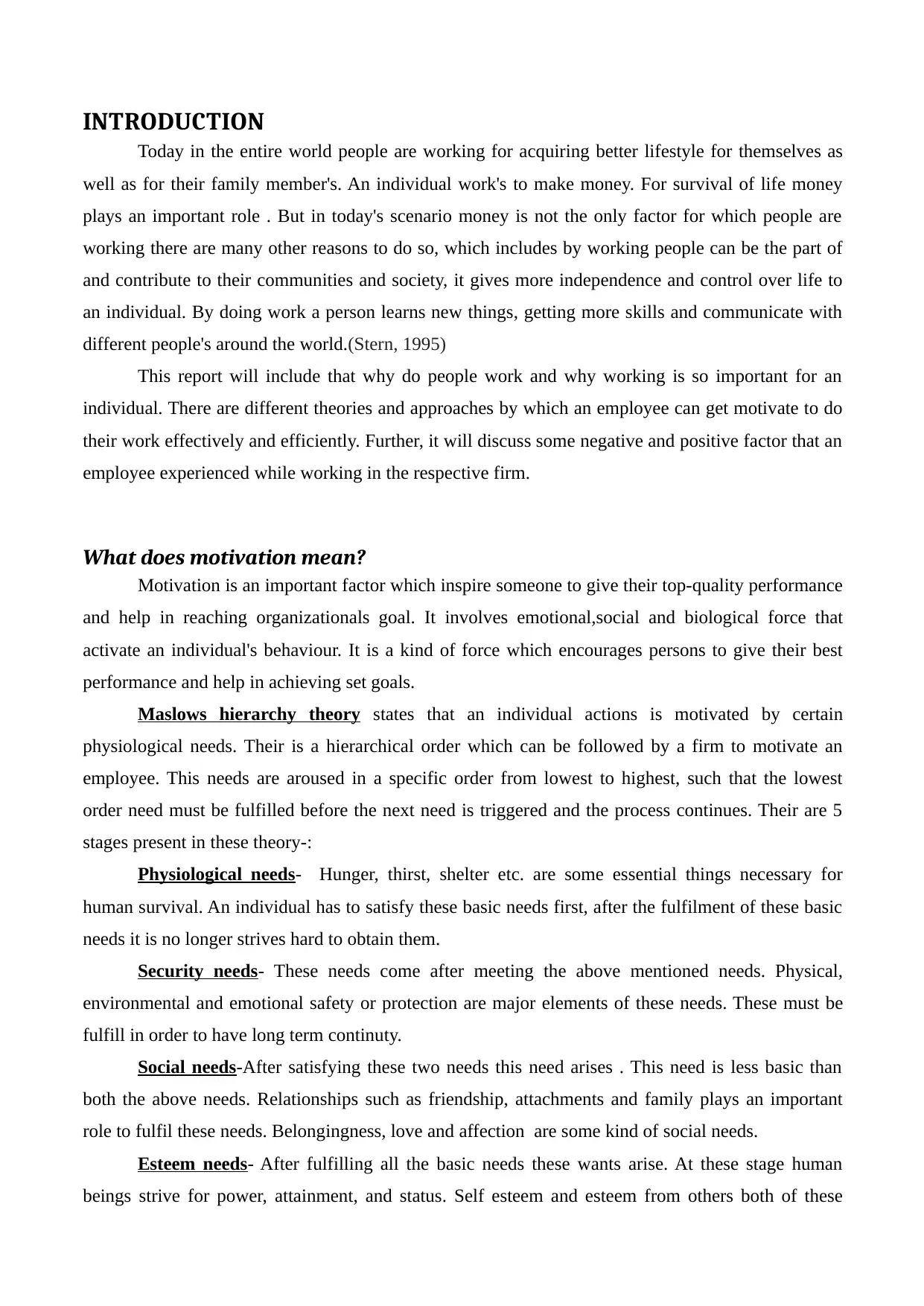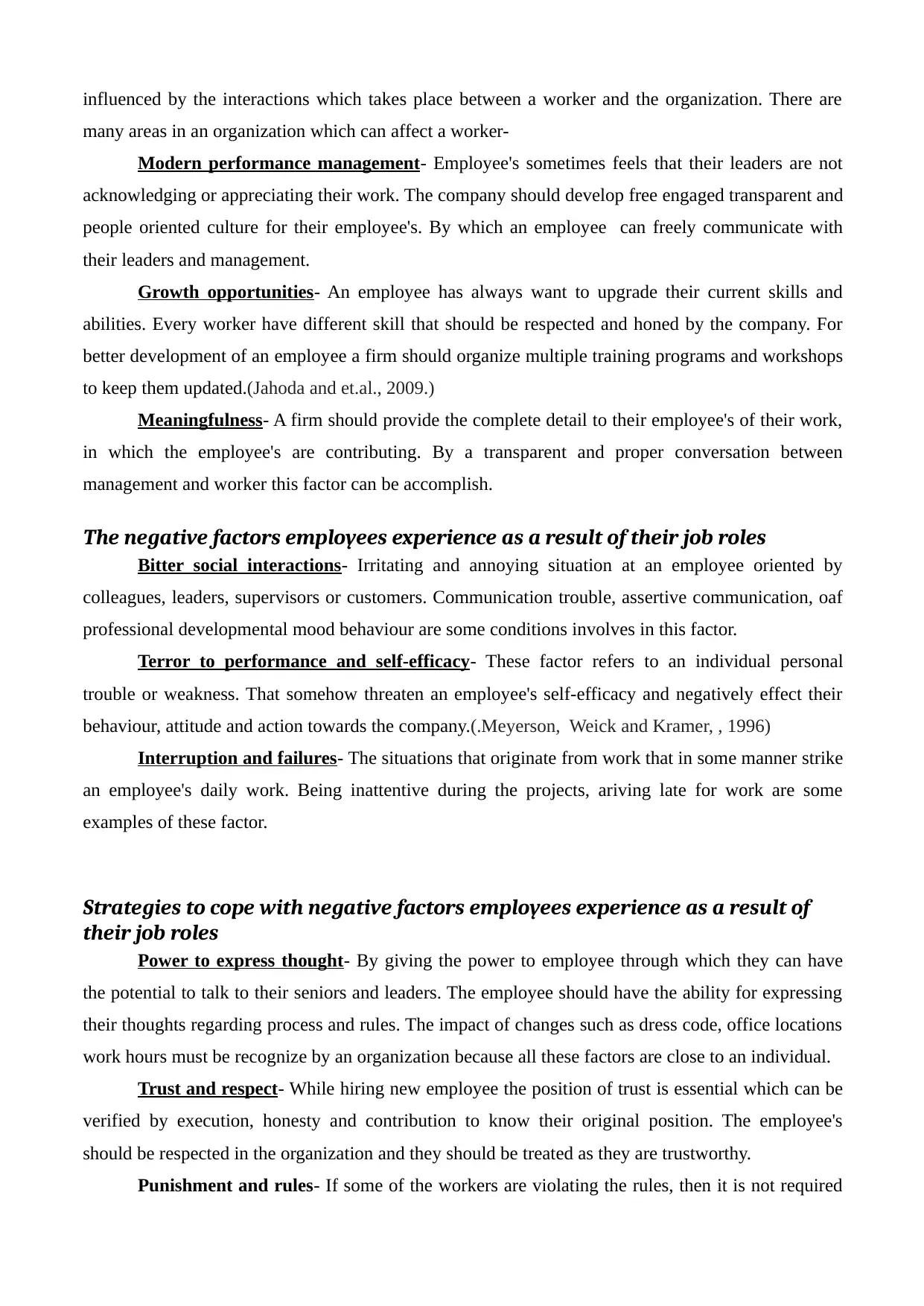Comprehensive Report on Employee Motivation: Factors and Strategies
VerifiedAdded on 2023/06/14
|6
|1876
|429
Report
AI Summary
This report delves into the multifaceted nature of employee motivation, emphasizing its importance in achieving organizational goals and enhancing individual well-being. It discusses various theories, including Maslow's hierarchy of needs, and differentiates between intrinsic and extrinsic motivation. The report identifies key motivational factors such as salary, promotion opportunities, and the work environment, while also addressing the positive aspects like growth opportunities and meaningfulness, and negative aspects such as bitter social interactions and performance anxieties encountered by employees. Furthermore, it proposes strategies to mitigate the negative impacts, including fostering open communication, trust, and fair rule enforcement. The conclusion underscores the significance of motivation in fulfilling basic needs and achieving set goals, highlighting the role of effective strategies in addressing negatively affected employees. Desklib provides access to this and other solved assignments for students.

Individual report
Paraphrase This Document
Need a fresh take? Get an instant paraphrase of this document with our AI Paraphraser

Contents
INTRODUCTION...................................................................................................................................3
What does motivation mean?..............................................................................................................3
The various factor which motivate employee-....................................................................................4
The positive factors employees experience as a result of their job roles-...........................................4
The negative factors employees experience as a result of their job roles...........................................5
Strategies to cope with negative factors employees experience as a result of their job roles.............5
CONCLUSION.......................................................................................................................................6
REFERENCES........................................................................................................................................6
INTRODUCTION...................................................................................................................................3
What does motivation mean?..............................................................................................................3
The various factor which motivate employee-....................................................................................4
The positive factors employees experience as a result of their job roles-...........................................4
The negative factors employees experience as a result of their job roles...........................................5
Strategies to cope with negative factors employees experience as a result of their job roles.............5
CONCLUSION.......................................................................................................................................6
REFERENCES........................................................................................................................................6

INTRODUCTION
Today in the entire world people are working for acquiring better lifestyle for themselves as
well as for their family member's. An individual work's to make money. For survival of life money
plays an important role . But in today's scenario money is not the only factor for which people are
working there are many other reasons to do so, which includes by working people can be the part of
and contribute to their communities and society, it gives more independence and control over life to
an individual. By doing work a person learns new things, getting more skills and communicate with
different people's around the world.(Stern, 1995)
This report will include that why do people work and why working is so important for an
individual. There are different theories and approaches by which an employee can get motivate to do
their work effectively and efficiently. Further, it will discuss some negative and positive factor that an
employee experienced while working in the respective firm.
What does motivation mean?
Motivation is an important factor which inspire someone to give their top-quality performance
and help in reaching organizationals goal. It involves emotional,social and biological force that
activate an individual's behaviour. It is a kind of force which encourages persons to give their best
performance and help in achieving set goals.
Maslows hierarchy theory states that an individual actions is motivated by certain
physiological needs. Their is a hierarchical order which can be followed by a firm to motivate an
employee. This needs are aroused in a specific order from lowest to highest, such that the lowest
order need must be fulfilled before the next need is triggered and the process continues. Their are 5
stages present in these theory-:
Physiological needs- Hunger, thirst, shelter etc. are some essential things necessary for
human survival. An individual has to satisfy these basic needs first, after the fulfilment of these basic
needs it is no longer strives hard to obtain them.
Security needs- These needs come after meeting the above mentioned needs. Physical,
environmental and emotional safety or protection are major elements of these needs. These must be
fulfill in order to have long term continuty.
Social needs-After satisfying these two needs this need arises . This need is less basic than
both the above needs. Relationships such as friendship, attachments and family plays an important
role to fulfil these needs. Belongingness, love and affection are some kind of social needs.
Esteem needs- After fulfilling all the basic needs these wants arise. At these stage human
beings strive for power, attainment, and status. Self esteem and esteem from others both of these
Today in the entire world people are working for acquiring better lifestyle for themselves as
well as for their family member's. An individual work's to make money. For survival of life money
plays an important role . But in today's scenario money is not the only factor for which people are
working there are many other reasons to do so, which includes by working people can be the part of
and contribute to their communities and society, it gives more independence and control over life to
an individual. By doing work a person learns new things, getting more skills and communicate with
different people's around the world.(Stern, 1995)
This report will include that why do people work and why working is so important for an
individual. There are different theories and approaches by which an employee can get motivate to do
their work effectively and efficiently. Further, it will discuss some negative and positive factor that an
employee experienced while working in the respective firm.
What does motivation mean?
Motivation is an important factor which inspire someone to give their top-quality performance
and help in reaching organizationals goal. It involves emotional,social and biological force that
activate an individual's behaviour. It is a kind of force which encourages persons to give their best
performance and help in achieving set goals.
Maslows hierarchy theory states that an individual actions is motivated by certain
physiological needs. Their is a hierarchical order which can be followed by a firm to motivate an
employee. This needs are aroused in a specific order from lowest to highest, such that the lowest
order need must be fulfilled before the next need is triggered and the process continues. Their are 5
stages present in these theory-:
Physiological needs- Hunger, thirst, shelter etc. are some essential things necessary for
human survival. An individual has to satisfy these basic needs first, after the fulfilment of these basic
needs it is no longer strives hard to obtain them.
Security needs- These needs come after meeting the above mentioned needs. Physical,
environmental and emotional safety or protection are major elements of these needs. These must be
fulfill in order to have long term continuty.
Social needs-After satisfying these two needs this need arises . This need is less basic than
both the above needs. Relationships such as friendship, attachments and family plays an important
role to fulfil these needs. Belongingness, love and affection are some kind of social needs.
Esteem needs- After fulfilling all the basic needs these wants arise. At these stage human
beings strive for power, attainment, and status. Self esteem and esteem from others both of these
⊘ This is a preview!⊘
Do you want full access?
Subscribe today to unlock all pages.

Trusted by 1+ million students worldwide

factors are include in this need.
Self-actualization needs- The fulfilment of this need gives a high degree of satisfaction to the
individual in life and work. Later these needs improves a person's performance in an organization. A
self- actualized person has fulfilled all his potential. These represents a person's motivation to
transform perception of self into reality. (Deterding, and et.al., 2011)
Extrinsic motivation takes place when a person is intended to execute a activity in order to
gain an external reward. An individual's is focused on an outcome and does not satisfy their basic
psychological needs because it involves money, fame and power. Intrinsic is a type of motivation
where an individual is motivated to do the activity because it is internally rewarding them. An
individual choose to do it because its enjoyable, not because of any outside pressures like rewards or
deadlines.
The various factor which motivate employee-
Salary:
Salary is not a motivation factor even though firm used it to motivate their employee's. The
employee's will never satisfy with the compensation providing by the company they always want
more. It becomes an issue when someone is getting higher salary as compare to the other employee
for performing similar task in same company. Pay for performance schemes and general setup of
payment plan are some type of assumption that money motivate an individual.
Promotion:
In organization promotion is effective for the employee behaviour that leads to positive
motivation and better in their performance. The promotion creates willingness and opportunity is
offered for better performing that improves their competencies. This is acknowledged as enhancement
in position of employee behaviour is evaluated.(Reid, 2015)
Work environment:
The work environment affects the employee's and their way of performing duties. In the
organisation there is need to create an healthy working environment , so that employee feel motivated
and enjoy their work. The employee behaviour is affected by several environmental aspects that
involves work structure, work environment, responsibilities, action of leaders, cooperation between
groups and smooth communication.
The positive factors employees experience as a result of their job roles-
The element that positively affect a worker while working in an organization. These can be
Self-actualization needs- The fulfilment of this need gives a high degree of satisfaction to the
individual in life and work. Later these needs improves a person's performance in an organization. A
self- actualized person has fulfilled all his potential. These represents a person's motivation to
transform perception of self into reality. (Deterding, and et.al., 2011)
Extrinsic motivation takes place when a person is intended to execute a activity in order to
gain an external reward. An individual's is focused on an outcome and does not satisfy their basic
psychological needs because it involves money, fame and power. Intrinsic is a type of motivation
where an individual is motivated to do the activity because it is internally rewarding them. An
individual choose to do it because its enjoyable, not because of any outside pressures like rewards or
deadlines.
The various factor which motivate employee-
Salary:
Salary is not a motivation factor even though firm used it to motivate their employee's. The
employee's will never satisfy with the compensation providing by the company they always want
more. It becomes an issue when someone is getting higher salary as compare to the other employee
for performing similar task in same company. Pay for performance schemes and general setup of
payment plan are some type of assumption that money motivate an individual.
Promotion:
In organization promotion is effective for the employee behaviour that leads to positive
motivation and better in their performance. The promotion creates willingness and opportunity is
offered for better performing that improves their competencies. This is acknowledged as enhancement
in position of employee behaviour is evaluated.(Reid, 2015)
Work environment:
The work environment affects the employee's and their way of performing duties. In the
organisation there is need to create an healthy working environment , so that employee feel motivated
and enjoy their work. The employee behaviour is affected by several environmental aspects that
involves work structure, work environment, responsibilities, action of leaders, cooperation between
groups and smooth communication.
The positive factors employees experience as a result of their job roles-
The element that positively affect a worker while working in an organization. These can be
Paraphrase This Document
Need a fresh take? Get an instant paraphrase of this document with our AI Paraphraser

influenced by the interactions which takes place between a worker and the organization. There are
many areas in an organization which can affect a worker-
Modern performance management- Employee's sometimes feels that their leaders are not
acknowledging or appreciating their work. The company should develop free engaged transparent and
people oriented culture for their employee's. By which an employee can freely communicate with
their leaders and management.
Growth opportunities- An employee has always want to upgrade their current skills and
abilities. Every worker have different skill that should be respected and honed by the company. For
better development of an employee a firm should organize multiple training programs and workshops
to keep them updated.(Jahoda and et.al., 2009.)
Meaningfulness- A firm should provide the complete detail to their employee's of their work,
in which the employee's are contributing. By a transparent and proper conversation between
management and worker this factor can be accomplish.
The negative factors employees experience as a result of their job roles
Bitter social interactions- Irritating and annoying situation at an employee oriented by
colleagues, leaders, supervisors or customers. Communication trouble, assertive communication, oaf
professional developmental mood behaviour are some conditions involves in this factor.
Terror to performance and self-efficacy- These factor refers to an individual personal
trouble or weakness. That somehow threaten an employee's self-efficacy and negatively effect their
behaviour, attitude and action towards the company.(.Meyerson, Weick and Kramer, , 1996)
Interruption and failures- The situations that originate from work that in some manner strike
an employee's daily work. Being inattentive during the projects, ariving late for work are some
examples of these factor.
Strategies to cope with negative factors employees experience as a result of
their job roles
Power to express thought- By giving the power to employee through which they can have
the potential to talk to their seniors and leaders. The employee should have the ability for expressing
their thoughts regarding process and rules. The impact of changes such as dress code, office locations
work hours must be recognize by an organization because all these factors are close to an individual.
Trust and respect- While hiring new employee the position of trust is essential which can be
verified by execution, honesty and contribution to know their original position. The employee's
should be respected in the organization and they should be treated as they are trustworthy.
Punishment and rules- If some of the workers are violating the rules, then it is not required
many areas in an organization which can affect a worker-
Modern performance management- Employee's sometimes feels that their leaders are not
acknowledging or appreciating their work. The company should develop free engaged transparent and
people oriented culture for their employee's. By which an employee can freely communicate with
their leaders and management.
Growth opportunities- An employee has always want to upgrade their current skills and
abilities. Every worker have different skill that should be respected and honed by the company. For
better development of an employee a firm should organize multiple training programs and workshops
to keep them updated.(Jahoda and et.al., 2009.)
Meaningfulness- A firm should provide the complete detail to their employee's of their work,
in which the employee's are contributing. By a transparent and proper conversation between
management and worker this factor can be accomplish.
The negative factors employees experience as a result of their job roles
Bitter social interactions- Irritating and annoying situation at an employee oriented by
colleagues, leaders, supervisors or customers. Communication trouble, assertive communication, oaf
professional developmental mood behaviour are some conditions involves in this factor.
Terror to performance and self-efficacy- These factor refers to an individual personal
trouble or weakness. That somehow threaten an employee's self-efficacy and negatively effect their
behaviour, attitude and action towards the company.(.Meyerson, Weick and Kramer, , 1996)
Interruption and failures- The situations that originate from work that in some manner strike
an employee's daily work. Being inattentive during the projects, ariving late for work are some
examples of these factor.
Strategies to cope with negative factors employees experience as a result of
their job roles
Power to express thought- By giving the power to employee through which they can have
the potential to talk to their seniors and leaders. The employee should have the ability for expressing
their thoughts regarding process and rules. The impact of changes such as dress code, office locations
work hours must be recognize by an organization because all these factors are close to an individual.
Trust and respect- While hiring new employee the position of trust is essential which can be
verified by execution, honesty and contribution to know their original position. The employee's
should be respected in the organization and they should be treated as they are trustworthy.
Punishment and rules- If some of the workers are violating the rules, then it is not required

for an organization to create or make strict rule for every employee's. By guiding the workers in a
proper way through various workshops, can minimize the number of rules of an organization.
Communicate- A firm should privately make it clear that they are facing problem. It can
defuse negativity and can lead to useful insights about management system. If employee's have the
knowledge of the weaknesses regarding to the firm than they can work accordingly, which can help
them to work fluently in an organization.(McMillen, 1999.)
CONCLUSION
From the above report it is concluded that an individual is working for living and satisfying their
basic needs and want for their survival. Motivation always plays an important role in a life of an
individual to achieve set goals. Maslow's hierarchy is one of the best theory for motivating a person.
Later it is divided into 2 parts intrinsic(internal factor) and extrinsic(external factor). Various element
are present which can motivate an employee to do their work more efficiently and effectively these
includes salary, promotion and work environment. Their are some negative and positive element
present that an employee is experienced in the firm where they are working. Terror to performance,
failure are some negative experienced faced by an employee. Growth opportunities and
meaningfulness are some positive factor experienced by an employee. Various strategies are also
present in these report like(communicate, trust and respect, rule and punishment) by practising some
of these strategies an organization can tackle negatively affected employee's.
REFERENCES
Deterding, and et.al., 2011. Gamification. using game-design elements in non-gaming contexts.
In CHI'11 extended abstracts on human factors in computing systems (pp. 2425-2428).
Jahoda and et.al., 2009. Starting a new job: The social and emotional experience of people with
intellectual disabilities. Journal of Applied Research in Intellectual Disabilities, 22(5),
pp.421-425.
McMillen, 1999. Better for it: How people benefit from adversity. Social work, 44(5), pp.455-468.
Meyerson, Weick and Kramer, , 1996. Swift trust and temporary groups. Trust in organizations:
Frontiers of theory and research, 166, p.195.
Reid, 2015. Embracing, passing, revealing, and the ideal worker image: How people navigate
expected and experienced professional identities. Organization Science, 26(4), pp.997-1017.
Stern, 1995. Why do people sacrifice for their nations?. Political psychology, pp.217-235.
proper way through various workshops, can minimize the number of rules of an organization.
Communicate- A firm should privately make it clear that they are facing problem. It can
defuse negativity and can lead to useful insights about management system. If employee's have the
knowledge of the weaknesses regarding to the firm than they can work accordingly, which can help
them to work fluently in an organization.(McMillen, 1999.)
CONCLUSION
From the above report it is concluded that an individual is working for living and satisfying their
basic needs and want for their survival. Motivation always plays an important role in a life of an
individual to achieve set goals. Maslow's hierarchy is one of the best theory for motivating a person.
Later it is divided into 2 parts intrinsic(internal factor) and extrinsic(external factor). Various element
are present which can motivate an employee to do their work more efficiently and effectively these
includes salary, promotion and work environment. Their are some negative and positive element
present that an employee is experienced in the firm where they are working. Terror to performance,
failure are some negative experienced faced by an employee. Growth opportunities and
meaningfulness are some positive factor experienced by an employee. Various strategies are also
present in these report like(communicate, trust and respect, rule and punishment) by practising some
of these strategies an organization can tackle negatively affected employee's.
REFERENCES
Deterding, and et.al., 2011. Gamification. using game-design elements in non-gaming contexts.
In CHI'11 extended abstracts on human factors in computing systems (pp. 2425-2428).
Jahoda and et.al., 2009. Starting a new job: The social and emotional experience of people with
intellectual disabilities. Journal of Applied Research in Intellectual Disabilities, 22(5),
pp.421-425.
McMillen, 1999. Better for it: How people benefit from adversity. Social work, 44(5), pp.455-468.
Meyerson, Weick and Kramer, , 1996. Swift trust and temporary groups. Trust in organizations:
Frontiers of theory and research, 166, p.195.
Reid, 2015. Embracing, passing, revealing, and the ideal worker image: How people navigate
expected and experienced professional identities. Organization Science, 26(4), pp.997-1017.
Stern, 1995. Why do people sacrifice for their nations?. Political psychology, pp.217-235.
⊘ This is a preview!⊘
Do you want full access?
Subscribe today to unlock all pages.

Trusted by 1+ million students worldwide
1 out of 6
Related Documents
Your All-in-One AI-Powered Toolkit for Academic Success.
+13062052269
info@desklib.com
Available 24*7 on WhatsApp / Email
![[object Object]](/_next/static/media/star-bottom.7253800d.svg)
Unlock your academic potential
Copyright © 2020–2025 A2Z Services. All Rights Reserved. Developed and managed by ZUCOL.


